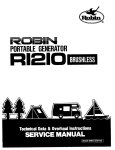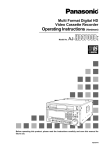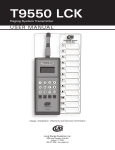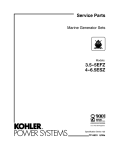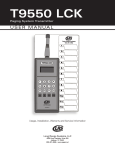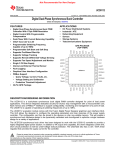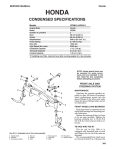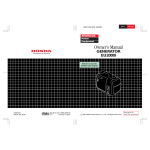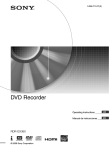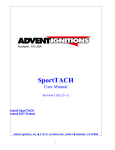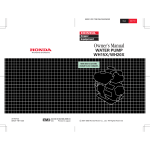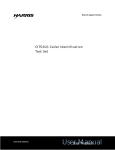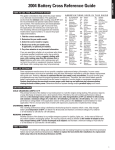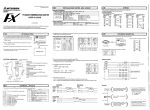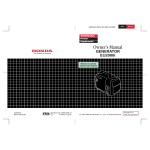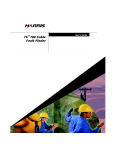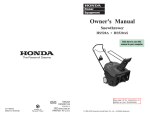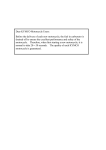Download Owner`s Manual EX5500
Transcript
Owner’s Manual EX5500 00X31 -ZAO-6000 Thank you for purchasing a Honda generator. This manual covers operation and maintenance of the EX5500 generator. All information in this publication is based on the latest product information available at the time of approval for printing. Honda Motor Co., Ltd. reserves the right to make changes at any time without notice and without incurring any obligation. . No part of this publication may be reproduced without This manual should be considered a permanent remain with the generator when sold. Pay special attention NOTE: Indicates a possibility are not followed. permission. part of the generator and to statements preceded by the following m Indicates a strong possibility life if instructions are not followed. CAUTION: instructions written words: of severe personal injury or loss of of personal injury or equipment damage if Gives helpful information. If a problem should arise, or if you have any questions about the generator, consult an authorized Honda dealer. B The Honda generator is designed to give safe and dependable service if operated according to instructions. Read and understand the Owner’s Manual before operating the generator. Failure to do so could result in personal injury or equipment damage. CONTENTS CONTENTS 1. GENERATOR SAFETY ....................... 2. COMPONENT IDENTIFICATION .................. 3. PRE-OPERATION CHECK ...................... 4. STARTING THE ENGINE ...................... 5:GENERATOR USE .......................... 6. STOPPING THE ENGINE ....................... 7. MAlNTENAi)lCE ........................... 8. TRANSPORTING/STORAGE .................... . 9. TROUBLESHOOTING ........................ 10. SPECIFICATIONS .......................... ......................... 11. WIRING DIAGRAM 12. INSTALLATION OF OPTIONAL PARTS ................ 1 2 4 8 12 14 16 25 27 29 30 31 I. GENERATOR SAFETY To ensure safe operation l l l l l l l Place the generator at least 1 m (3 ft) away from buildings or other equipment when operating the generator. Operate the generator on a level surface. If the generator is tilted, fuel spillage may result. Exhaust gas contains poisonous carbon monoxide. Never run the generator in an enclosed area. Be sure to provide adequate ventilation. Know how to stop the generator quickly and understand operation of all the controls. Never permit anyone to operate the generator without proper instructions. Keep children and pets away from the generator when it is in operation. Keep away from rotating parts while the generator is running. The generator is a potential source of electrical shocks when misused; do not operate with wet hands. Do not operate the generator in rain or snow and do not let it get wet. 2. COMPONENT AIR IDENTIFICATION CLEANER TOP COVER LOCK L .GROUND TERMlNAL-------- ENGINE r FUEL GAUGE MUFFLER 2 -- - OIL -ENGINE FILLER CAP OIL FILTER CONTROL BOX VOLTAGE ADJUSTMENT KNOB PILOT LAMP VOLTMETER RESET BUTTON r 1 Cl RCUIT BREAKERS AUTO-THROTTLE SWITCH REMOTE CONTROL SWITCH FUEL VALVE KNOB AC RECEPTACLES ENGINE SWITCH 3 3. PRE-OPERATION CAUTION: stopped. CHECK- Be sure to check the generator on a level surface with the engine 1. Check the engine oil level. CAUTION: Engine oil is a major factor affecting engine performance service life. Non-detergent or vegetable oils are not recommended. and Use Honda 4-stroke oil, or an equivalent high detergent, premium quality motor oil certified to meet or exceed U.S. automobile manufacturer’s requirements for Service Classification SE or SF. (Motor oils classified SE or SF will show this designation on the container.) SAE low-40 is recommended for general, all-temperature use. If single viscosity oil is used, select the appropriate viscosity for the average temperature in your area. Remove the oil filler cap and check the oil level. If the level is low, fill to the top of the oil filler recommended oil. Total oil capacity: neck with the i .4 P (1.48 US qt) u -w-w----. -w-w----------w ------w *-w---w + UPPER LEVEL 1.4 P (1.48 us qt) OIL FILLER CAP .-20 4 0 20 40 .00 80 IW’F 2. Check the fuel level. Use any regular grade automotive gasoline (unleaded gasoline is preferred) with a pump octane rating of 86 or higher. Never use an oil/gasoline mixture or dirty gasoline. Avoid getting dirt, dust or water in the fuel tank. CAUTION: Gasoline substitutes are not harmful to the fuel system components. Fuel tank capacity: recommended; they may be 16.5 P (4.36 US gal 1 mm!! Gasoline is extremely flammable and explosive under certain conditions. Refuel in a well ventilated area with the engine stopped. Do not smoke or allow flames or sparks in the area where the generator is refueled or where gasoline is stored. Do not overfill the tank and make sure the filler cap is securely closed after refueling. Be careful not to spill fuel when refueling. Fuel vapor or spilled fuel may ignite. If any fuel is spilled, make sure the area is dry before starting the engine. . FUEL HANK CAP 5 3. Check the coolant level. If there is no coolant in the reserve tank, check the cooling system for leaks and repair if necessary. Add coolant to the radiator, then check the coolant level in the reserve tank after the engine reaches operating temperature. M Never remove the radiator cap when the engine is hot. The coolant is under pressure and severe scalding could result. When the engine is at operating temperature, the coolant level should be between the MIN and MAX marks on the reserve tank. If the level is near the MIN mark, add coolant to bring it up to the MAX mark. Coolant Recommendation Use high quality ethylene glycol antifreeze use in aluminum engines. Mix the antifreeze or distilled water. that is specifically with low-mineral formulated for drinking water A 50/50 mixture of ethylene glycol antifreeze and water is recommended for most temperatures and provides good corrosion protection. A higher concentration of antifreeze decreases cooling efficiency and is recommended only if additional protection against freezing is needed. A concentration of less than 40% antifreeze will not provide proper corrosion protection. CAUTION: The use of unsuitable antifreeze, hard water, or salt water may cause corrosion damage that will shorten the life of the engine. lLOWER 6 LEVEL) RESERVE TANK 4. Check the battery. The electrolyte level must be maintained between the UPPER and LOWER level marks. If the electrolyte level is near the LOWER mark, add distilled water. l l The batterv contains sulfuric acid. Avoid contact with skin, eyes or clothing. Antidote: EXTERNAL - Flush with water. INTERNAL Drink large quantities of water or milk. Follow with milk of magnesia, beaten egg or vegetable oil. Call a physician immediately. Eyes: Flush with water and get prompt medical attention. Batteries produce explosive gases. Keep sparks, flames and cigarettes away. Always shield the eyes when working near batteries. CAUTION: Use only distilled water in the battery. Tap water will shorten the service life of the battery. l Do not fill the battery beyond the UPPER level. If overfilled, electrolyte may overflow and corrode generator components. Immediately wash off any spilled electrolyte. l Check the battery terminals to be sure the cables are tightened and free of corrosion. Remove any corrosion and coat the terminals and cable ends with grease. UPPER LOWER LEV LEVEL 7 4. STARTING 1. Turn the fuel , 8 valve - - THE IENGINE ON. 4 2. Make sure that the circuit breakers are OFF. The generator may be hard to start if a load is connected. CIRCUIT-BREAKERS ( 0II c 0 c - 9 3. Make sure the auto-throttle warm up. AUTO-THROTTLE switch is off, or more time will be required for SWITCH 9 4.Turn the engine switch to START and hold it there until the engine starts. Do not use the electric starter for more than 5 seconds at a time. If the engine fails to start, release the switch and wait 10 seconds before operating the starter again. NOTE: When the speed of the starter motor drops after a period of time, it is an indication that the battery should be recharged l NOTE: It is normal for the oil lamp to remain lit during starting.‘ If the oil level is OK, the oil lamp will go off when the engine is running. If the oil level is low, the oil lamp will stay on; the engine may start but will not continue to run. 10 5. After the engine starts, let the engine-switch ENGINE return to ON. SWITCH 6. Warm up the engine for 2-3 minutes. AUTO after the engine has warmed up. Turn the auto-throttle switch to 5. GENERATOR USE M To prevent electrical shock from faulty appliances, the generator should be grounded. Connect a length of heavy wire between the ground terminal and the ground source. CAUTION: Limit operation requiring maximum power (5.5 KVA) to 30 minutes. For continuous operation, do not exceed the rated power of 5.0 KVA. In either case, the total wattage of all appliances connected must be considered. l Connections for standby power to household circuits must be made by a qualified electrician and must comply with all applicable laws and electrical codes. Improper installation may result in personal injury or damage to equipment or property. Auto-throttle system With the switch in the AUTO position, engine speed is automatically reduced to an idle when all loads are turned off or disconnected. When appliances are turned on or reconnected, the engine resumes the rated speed. At OFF, the auto-throttle system does not operate. NOTE: l AUTO is recommended to minimize fuel consumption. l The auto-throttle system will not respond to electrical loads of less than 1 ampere. l The system is not effective for use with appliance that requires only momentary power. To avoid extended warm-up periods, keep the switch OFF until the engine reaches operating temperature. Engine Protection Circuit If the oil or coolant level runs low during operation, automatically stop the engine to prevent damage. the protection circuit will If this occurs, add oil or coolant as required, push the reset button restart the engine. RESET OIL LAMP in, then BUTTON CAUTION: If engine idle speed is set too low, the protection circuit cannot be activated while idling. The correct idle speed is 2200 f 200 rpm. 12 COOLANT LAMP Operation 1. Start the engine and make sure that the pilot 2. Switch on the circuit breakers. 3. Plug in the appliance. lamp comes on. NOTE: Connect 120V appliances to the 120V receptacles. You can use both 12OV/24OV appliances with the 12OV/24OV receptacle. CAUTION: Be sure that appliances do not exceed the rated load for more than 30 minutes, and never exceed the maximum load. Substantial. overloading will switch off the circuit breaker. Lesser overloading will not switch off the circuit breaker and will shorten the service life of the generator. NOTE: This generator is equipped with an AVR (Automatic Voltage Regulator). Though voltage adjustment is not required, fine adjustments may be made by turning the voltage adjustment knob. Use the generator at the specified voltage. AIR dlRCUlT BREAKERS 13 6. STOPPING THE ENGINE To stop the engine in an emergency, move the engine switch to OFF. In normal use: 1. Turn the circuit breakers OFF. CIRCUIT BREAKERS I I 2. Turn the engine switch OFF. ENGINE 14 SWITCH 3. Turn the fuel valve OFF. FUELVALVE KNOB / ’ ’ 15 7. MAINTENANCE The purpose of the maintenance schedule and adjustment generator in the best operating condition. Inspect or service as scheduled in the table on the next page. is to keep the M Shut off the engine before performing any maintenance. If the engine must be run, make sure the area is well ventilated. The exhaust contains poisonous carbon monoxide gas. CAUTION: replacement generator. Use only genuine HONDA parts or their equivalent. The use of parts which are not of equivalent quality may damage the . 16 Maintenance Schedule orm at every indiating hour interval, whichever occurs NOTE (1 J : Service more frequently when used in dusty areas, (2) : These items should be serviced by an authorized Honda dealer, unless the owner has the proper tools and is mechanically proficient. See the Honda Shop Manual. Toll kit The tools supplied are necessary for performing simple adjustments and repairs. Always keep the kit with the generator. some periodic maintenance, Engine oil and oil filter change Drain the oil while the engine is still warm to assure rapid and complete draining. 1. Remove the drain plug and filler cap, and drain the oil. Retighten the plug securely, and reinstall the filler cap. 2. Remove the oil filter with a filter wrench and let the remaining oil drain out. 3. Apply a thin coat of engine oil to the filter rubber seal and screw it in by hand until you feel it seat against the engine, then turn it 314 of a turn more. 4. Fill the crankcase with the recommended oil (See page 4) and check the level. Recheck the level after running the engine for a few minutes. Total oil capacity: 1.4 P (1.48 US qt) Air cleaner service A dirty air cleaner will restrict air flow to the carburetor. To prevent carburetor malfunction, service the air cleaner regularly (page 23). Service more frequently when operating the generator in extremely dusty areas. N Never use gasoline or low flash point solvents for cleaning the air cleaner elements. A fire or explosion could result. CAUTION: Never run the generator without wear may result. the air cleaner. Rapid engine 1. Pull the lock levers out and open the top cover. 2. Unscrew the wing nut and remove the air cleaner cover. 3. Remove the urethane and paper elements. WIN 9 NUT COVER AIR CLEANid ELEMENTS (URETHANE AND PAPER) 19 4. Carefully check both elements for holes or tears and replace as required. Damaged elements will pass dirt into the system. Always clean the filter housing and air passages before installing clean elements. 5. Foam element: Clean in warm soapy water: rinse and allow to dry thoroughly. Or clean in high flash-point solvent and allow to dry. Dip the element in clean engine oil and squeeze out all the excess. The engine will smoke during initial start-up if too much oil is left in the foam. 6. Paper element: Tap the element lightly several times on a hard surface to remove excess dirt, or blow compressed air through the filter from the inside out. Never try to brush the dirt off: brushing will force dirt into the fibers. Clean in warm, soapy water and rinse. Dry using compressed air blown from the inside out, or shake the element and allow it to air dry thoroughly. (Or clean in high flash-point solvent, remove immediately, and allow to dry.) Oil the outside of the paper with a light aerosol oil such as WD-46. The engine will smoke during initial start-up if too much oil is used. 7. Reinstall the elements and air cleaner cover with the arrow on the cover aligned with the arrow on the frame. Tighten the wing nut securely. 8. Reinstall the top cover. URETHA‘NE 20 ELEMENT Fuel filter service The filter prevents dirt or water which may be in the fuel tank from entering the carburetor. If the engine has not been run for a long time, the filter should be cleaned. 1. Turn the two lock pins and open the carburetor cover. 2. Turn the fuel valve OFF. Remove the filter cup. 3. Clean the cup thoroughly. 4. Reassemble. Do not damage the O-ring. 5. Close the carburetor cover and lock with the lock pins. B After installing the filter cup, check for fuel leaks and make sure the area is dry before starting the engine. FILTER CUP 21 Spark plug service Recommended spark plug: BPRGHS-10 (NGK) To ensure proper engine operation, and free of deposits. the spark plug must be properly gapped 1. 2. 3. 4. Pull the lock levers out and open the top cover. Remove the spark plug cap. Use the wrench supplied in the tool kit to remove the spark plug. Visually inspect the spark plug. Discard it if the insulator is cracked or chipped. 5. Measure the plug gap with a feeler gauge. The gap should be 0.9-1.0 mm (0.035-0.039 in). Correct as necessary by bending the side electrode. 6. Attach the plug washer. Thread the plug in by hand to, prevent cross-threading. 7. Tighten a new spark plug l/2 turn with the wrench to compress the washer. If you are reusing a plug, it should only take l/8-1/4 turn after the plug seats. 8. Reinstall the top cover. CAUTION : l The spark plug must be securely tightened. An improperly can become very hot and possibly damage the generator. l Never use a spark plug with an improper heat range. tightened plug PLUG GAP 0.9-1.0 mm (0.035-0.039 PLUG WRENCH in1 Fuse replacement If the fuse is blown, the engine will not start until it is replaced. 1. Pull the lock levers out and open the top cover. 2. Turn the engine switch OFF. 3. Remove the fuse holder and replace the fuse. Use only a 10A fuse. 4. Close the top cover. CAUTION: If frequent fuse failure occurs, determine the cause and correct the problem before attempting to bperate the generator further. Never use a fuse with a rating other than 10A. Serious damage to the electrical system or a fire may result. FUSE HOLDER 23 Spark arrester maintenance m If the generator has been running, Allow it to cool before proceeding. the muffler will be very hot. CAUTION: The spark arrester must be serviced every 100 hours to maintain its efficiency. 1. Loosen two 5 mm pan screws on the arrester cap. 2. Remove the arrester cap, then pull out spark arrester taking care not to damage the wire mesh. 3. Check the muffler exhaust port for carbon deposits; clean if necessary. 4. Install the spark arrester and arrester cap on the muffler. 5. Tighten two 5 mm pan screws to the arrester cap. _ ARRESTER ARRESTER 24 CAP 8. TRANSPORTING/STORAGE m When transporting the generator, turn the engine switch OFF and keep the generator level to prevent fuel spillage. Fuel vapor or spilled fuel may ignite. Before storing the unit for an extended period: 1. Be sure the storage area is free of excessive humidity and dust. 2. Drain the fuel a. With the fuel valve OFF, remove and empty the filter cup. b. Turn the fuel valve ON and drain the gasoline in the fuel tank into a suitable container. c. Replace the filter cup and tighten securely. FILTER CUP 25 d. Drain the carburetor by loosening the drain screw. Drain the gasoline into a suitable container. -- P DRAIN 3. Once a month, recharge the battery. 26 SCREW 9. TROUBLESHOOTING A. When the engine will not start: 1. Is there enough fuel? 2. Is the fuel valve on? 3. Is gasoline reaching the carburetor? To check, loosen the drain screw with the fuel valve on. bw If any fuel is spilled, make sure the area is dry before testing the spark plug or starting the engine. Fuel vapor or spilled fuel may ignite. DRAIN SCREW I 4. Is the reset button pushed in? 5. Are the circuit breakers off? 6. Is the engine switch on? 7. Is the fuse good? 8. Is there a spark at the spark plug (Page 28)? 27 a. Remove the spark plug cap. Clean any dirt from around the spark plug base, then remove the spark plug. b. Install the spark plug in the plug cap. c. Turn the engine switch on. d. Grounding the side electrode to any engine ground, crank the engine to see if sparks jump across the gap. e. If there are no sparks, replace the plug. If OK, try to start the engine according to the instructions. 9. If the engine still does not start, take the generator to the dealer. B. When the engine starts but stops immediately: a. Is there enough oil in the crankcase? If not, the oil lamp will go on. b. Is there enough coolant in the radiator (is the engine overheated)? If not, the coolant lamp will go on. C. No electricity at the output receptacles: Are the circuit breakers on? 28 10. SPEClFlCATlONS Dimension Length x Width x Height 965x590x730mm (38.0 x 23.2 x 28.7 in) Dry weight 175 kg (385.9 lb) Engine Model Engine Type Displacement [Bore x Stroke] Compression Ratio Engine Speed Ignition System Oil Capacity Cooling System Capacity Fuel Tank Capacity Spark plug Honda GX360 4Stroke, O.H.C. 2 cylinder 359 cm3 (21 .Q cu in) (58 x 68 mm (2.3 x 2.7 in)1 8.5 :1 3,600 rpm C.D.I. 1.4 P (1.48 US qt) 2.0 P (2.11 us qt) 16.5 P (4.36 US gal) BPRGHS-10 (NGK) Generator AC output Rated voltage Rated frequency Rated ampere Rated output Maximum output 12OJ240 V 60 Hz 41.7120.8A 5.0 KVA 5.5 KVA 1 29 c = - 12. INSTALLATION OF OPTIONAL PARTS Remote control kit The generator may be adapted for remote control operation by use of an optional kit. 1. Unscrew the two 6 x 10 mm flange bolts and 6 x 8 mm screws attaching the control panel. Remove the control panel. 6 x 10 mm FLANGE BOLTS 2. Position the relay box on the back of the control panel with the studs inserted through the holes in the relay box flange. Install a 4 mm nut and lock washer on each stud and tighten securely. 3. Remove the 6-P coupler with a jumper wire from the wire harness female coupler. Connect the relay box 6-P male coupler to the wire harness female coupler. 4. Insert the relay box 6-P female coupler in the hole in the sub panel below the control panel and install with the two self-tapping screws and coupler holder. 4 x 10 mm SELFTAPPING SCREWS COUPLER CONTROL HOLE 4 mm’NUT HOLDER IN SUB PANEL 31 5. Reinstall the control panel with the 6 x 10 mm flange bolts and 6 x 8 mm screws. 6. Connect the remote control 6-P male coupler to the 6-P coupler on the sub panel. 6-P FEMALE COUPLER RE CO CA 7. Connect the remote control 32 6-P male coupler to the switch box. Remote control operation (STARTING) . i. Turn the fuel valve on. 2. Turn the auto-throttle switch off. 3. Turn the ignition switch key off or remove it from the generator. 41 Turn the relay switch on. 5. Flip the remote control engine switch knob up to ON. IN6lNt SW 33 6. Depress the starter button until the pilot lamp is on. 34








































